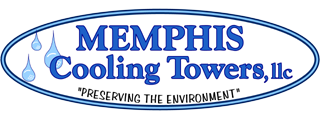
Memphis Cooling Towers specializes in the selection and installation of the best evaporative cooling products for your application.
FACTS
Memphis Cooling Towers, llc
• • •


Find information that will aid your in your decision here. Helping our customers is MCT's first priority.
For more expert advice and any help you may need don't hesitate to give us a call at
(901) 820-4423 !
(901) 820-4423 !
Important Considerations when
Evaluating Cooling Towers
Evaluating Cooling Towers

Drift Eliminators are the final defense against water loss from a cooling tower. Cooling Tower Drift is measured in percent of the water flow rate. Excessive drift wastes water, water treatment chemicals and is potentially damaging to roofs, windows, automobiles and pedestrians.
For Low Drift rates, specify Counterflow, Induced Draft Cooling Tower
Drift Rate 0.001% of circulating flow rate, the best in the industry!
No “rain effect” when walking next to a counterflow, induced draft cooling tower.
Water and water treatment cost savings.
Drift eliminators can be easily removed.
Crossflow, Induced Draft Cooling Towers:
0.005% drift rate. Five (5) times greater than counterflow.
Potential damage to property due to excessive drift.
Drift Eliminators are integral to the fill.
High Drift Example: 500 Nominal Tons - 1,500 gpm flow rate:
Crossflow - 0.005% of 1,500 gpm = 0.00005 x 1,500 gpm
= 0.075 gal./min
= 4.5 gal./hr.
= 108 gal./day water loss
Counterflow - 0.001% of 1,500 gpm = 0.00001 x 1,500 gpm
= 0.015 gal./min.
= 0.90 gal./hr
= 21.6 gal./day water loss
Counterflow will save 86 gallons of water and water treatment daily.
86 Gallons/Day x 365 days = 31,390 Gallons…..on automobiles, sides of building, windows, roof, pedestrians, etc.
For Low Drift rates, specify Counterflow, Induced Draft Cooling Tower
Drift Rate 0.001% of circulating flow rate, the best in the industry!
No “rain effect” when walking next to a counterflow, induced draft cooling tower.
Water and water treatment cost savings.
Drift eliminators can be easily removed.
Crossflow, Induced Draft Cooling Towers:
0.005% drift rate. Five (5) times greater than counterflow.
Potential damage to property due to excessive drift.
Drift Eliminators are integral to the fill.
High Drift Example: 500 Nominal Tons - 1,500 gpm flow rate:
Crossflow - 0.005% of 1,500 gpm = 0.00005 x 1,500 gpm
= 0.075 gal./min
= 4.5 gal./hr.
= 108 gal./day water loss
Counterflow - 0.001% of 1,500 gpm = 0.00001 x 1,500 gpm
= 0.015 gal./min.
= 0.90 gal./hr
= 21.6 gal./day water loss
Counterflow will save 86 gallons of water and water treatment daily.
86 Gallons/Day x 365 days = 31,390 Gallons…..on automobiles, sides of building, windows, roof, pedestrians, etc.
Sound is an environmental issue that people are becoming more and more sensitive of. Cooling towers do not have to be a source of unacceptable sound.
up to - 15 dB(A) Reduction versus Standard Fan! Super Low Sound Fans are available that utilize an extremely wide chord blade design available for sound sensitive applications where the lowest sound levels are desired. The fan is one-piece molded heavy duty FRP construction utilizing a forward swept blade design. The Super Low Sound fan is capable of reducing the unit sound pressure levels depending on specific unit selection and measurement location. The fans are high efficiency axial propeller type and operate with no loss of thermal performance.
up to -7 dB(A) Reduction! Low Sound Fans are available that use a wide chord blade design available for sound sensitive applications where low sound levels are desired. It is aluminum blade construction with a steel fan hub. The Low Sound Fan is capable of reducing the unit sound pressure levels location. The fans are high efficiency axial propeller type and operate with no loss of thermal performance.
up to -10 dB(A) Reduction! Fan Discharge Attenuators are an additional option available to further reduce the sound level of the unit. The attenuator can be used with the standard fan or in combination with the Low Sound Fan option.
The discharge attenuator is a factory assembled straight sided discharge hood designed to reduce overall discharge sound levels at full fan speed specific unit selection and measurement location. It is constructed of G-235 galvanized steel as standard (options available for Type 304 stainless steel) and includes insulated walls and a low pressure drop baffling system that is acoustically lined with high density fiberglass. The discharge attenuator is supported entirely by the unit and is shipped as an assembled section for easy mounting in the field. The discharge attenuator is covered by a heavy gauge hot dip galvanized steel fan guard to prevent debris from entering the attenuator.
The discharge attenuator normally have a minimal impact on unit thermal performance (0%-2% derate is normal - depending on specific job site conditions).
up to - 15 dB(A) Reduction versus Standard Fan! Super Low Sound Fans are available that utilize an extremely wide chord blade design available for sound sensitive applications where the lowest sound levels are desired. The fan is one-piece molded heavy duty FRP construction utilizing a forward swept blade design. The Super Low Sound fan is capable of reducing the unit sound pressure levels depending on specific unit selection and measurement location. The fans are high efficiency axial propeller type and operate with no loss of thermal performance.
up to -7 dB(A) Reduction! Low Sound Fans are available that use a wide chord blade design available for sound sensitive applications where low sound levels are desired. It is aluminum blade construction with a steel fan hub. The Low Sound Fan is capable of reducing the unit sound pressure levels location. The fans are high efficiency axial propeller type and operate with no loss of thermal performance.
up to -10 dB(A) Reduction! Fan Discharge Attenuators are an additional option available to further reduce the sound level of the unit. The attenuator can be used with the standard fan or in combination with the Low Sound Fan option.
The discharge attenuator is a factory assembled straight sided discharge hood designed to reduce overall discharge sound levels at full fan speed specific unit selection and measurement location. It is constructed of G-235 galvanized steel as standard (options available for Type 304 stainless steel) and includes insulated walls and a low pressure drop baffling system that is acoustically lined with high density fiberglass. The discharge attenuator is supported entirely by the unit and is shipped as an assembled section for easy mounting in the field. The discharge attenuator is covered by a heavy gauge hot dip galvanized steel fan guard to prevent debris from entering the attenuator.
The discharge attenuator normally have a minimal impact on unit thermal performance (0%-2% derate is normal - depending on specific job site conditions).
DRIFT
SOUND
STAINLESS STEEL
The chemical compositions of Type 304 and 316 stainless steel are similar, but 316 provides ten times the corrosion protection in cooling tower applications.
There are several differences allow Type 316 SS to have better corrosion resistance than Type 304 SS. Type 316 SS contains molybdenum (304 SS does not) and has a greater percentage of nickel than Type 304 SS. The molybdenum-bearing Type 316 SS provides superior corrosion resistance to a wide variety of environments.
Also, resistance of stainless steels to pitting and/or crevice corrosion in the presence of chloride or other halide ions is enhanced by molybdenum content. A measure of pitting resistance is expressed by the PREN (Pitting Resistance Equivalent, including Nitrogen) calculation. The Type 316 SS PREN of 24 is considerably higher than the Type 304 SS PREN of 19, reflecting the better pitting resistance provided by Type 316 SS due to its molybdenum content. It is generally accepted that Mo-bearing Type 316SS material can accommodate water with chloride content ten times greater than Type 304SS.
Furthermore, Type 316SS eliminates the aesthetic degradation associated with staining of Type 304SS.
Type 316 SS material offers the best protection against corrosion and is a better choice for cooling tower applications.
There are several differences allow Type 316 SS to have better corrosion resistance than Type 304 SS. Type 316 SS contains molybdenum (304 SS does not) and has a greater percentage of nickel than Type 304 SS. The molybdenum-bearing Type 316 SS provides superior corrosion resistance to a wide variety of environments.
Also, resistance of stainless steels to pitting and/or crevice corrosion in the presence of chloride or other halide ions is enhanced by molybdenum content. A measure of pitting resistance is expressed by the PREN (Pitting Resistance Equivalent, including Nitrogen) calculation. The Type 316 SS PREN of 24 is considerably higher than the Type 304 SS PREN of 19, reflecting the better pitting resistance provided by Type 316 SS due to its molybdenum content. It is generally accepted that Mo-bearing Type 316SS material can accommodate water with chloride content ten times greater than Type 304SS.
Furthermore, Type 316SS eliminates the aesthetic degradation associated with staining of Type 304SS.
Type 316 SS material offers the best protection against corrosion and is a better choice for cooling tower applications.
